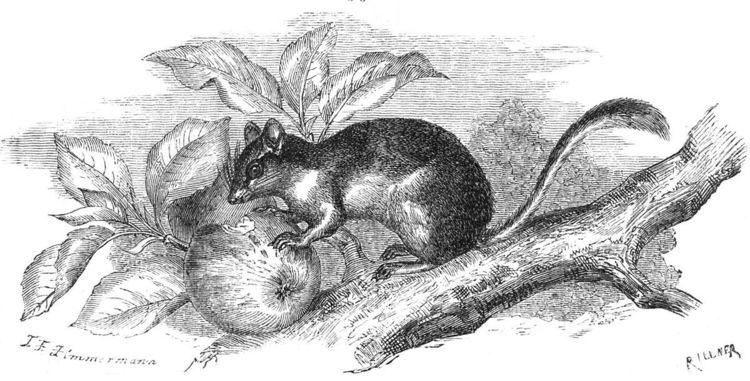This is a list of the mammal species recorded in Luxembourg. There are 46 mammal species in Luxembourg, of which 0 are critically endangered, 0 are endangered, 3 are vulnerable, and 1 is near-threatened.
The following tags are used to highlight each species' conservation status as assessed by the IUCN:
Some species were assessed using an earlier set of criteria. Species assessed using this system have the following instead of near threatened and least concern categories:
Rodents make up the largest order of mammals, with over 40 percent of mammalian species. They have two incisors in the upper and lower jaw which grow continually and must be keep short by gnawing. Most rodents are small though the capybara can weigh up to 45 kg (100 lb).
Suborder: Sciurognathi
Family: Gliridae (dormice)
Subfamily: Leithiinae
Genus: Eliomys
Garden dormouse Eliomys quercinus VU
Family: Cricetidae
Subfamily: Cricetinae
Genus: Cricetus
European hamster Cricetus cricetus LR/lc
Subfamily: Arvicolinae
Genus: Arvicola
Water vole Arvicola terrestris LR/lc
Genus: Clethrionomys
Bank vole Clethrionomys glareolus LR/lc
Genus: Microtus
Field vole Microtus agrestis LR/lc
Common vole Microtus arvalis LR/lc
European pine vole Microtus subterraneus LR/lc
Family: Muridae (mice, rats, voles, gerbils, hamsters, etc.)
Subfamily: Murinae
Genus: Apodemus
Yellow-necked mouse Apodemus flavicollis LR/lc
Wood mouse Apodemus sylvaticus LC
The order Erinaceomorpha contains a single family, Erinaceidae, which comprise the hedgehogs and gymnures. The hedgehogs are easily recognised by their spines while gymnures look more like large rats.
Family: Erinaceidae (hedgehogs)
Subfamily: Erinaceinae
Genus: Erinaceus
West European hedgehog Erinaceus europaeus LR/lc
The "shrew-forms" are insectivorous mammals. The shrews and solenodons closely resemble mice while the moles are stout-bodied burrowers.
Family: Soricidae (shrews)
Subfamily: Crocidurinae
Genus: Crocidura
Bicolored shrew Crocidura leucodon LR/lc
Greater white-toothed shrew Crocidura russula LC
Subfamily: Soricinae
Tribe: Nectogalini
Genus: Neomys
Eurasian water shrew Neomys fodiens LR/lc
Tribe: Soricini
Genus: Sorex
Common shrew Sorex araneus LR/lc
Eurasian pygmy shrew Sorex minutus LR/lc
Family: Talpidae (moles)
Subfamily: Talpinae
Tribe: Talpini
Genus: Talpa
European mole Talpa europaea LR/lc
The bats' most distinguishing feature is that their forelimbs are developed as wings, making them the only mammals in the world naturally capable of flight. Bat species account for about 20% of all mammals.
Family: Vespertilionidae
Subfamily: Myotinae
Genus: Myotis
Brandt's bat Myotis brandti LR/lc
Pond bat Myotis dasycneme VU
Daubenton's bat Myotis daubentonii LR/lc
Greater mouse-eared bat Myotis myotis LR/nt
Whiskered bat Myotis mystacinus LR/lc
Natterer's bat Myotis nattereri LR/lc
Subfamily: Vespertilioninae
Genus: Barbastella
Barbastelle Barbastella barbastellus VU
Genus: Eptesicus
Serotine bat Eptesicus serotinus LR/lc
Genus: Nyctalus
Lesser noctule Nyctalus leisleri LR/nt
Common noctule Nyctalus noctula LR/lc
Genus: Pipistrellus
Nathusius' pipistrelle Pipistrellus nathusii LR/lc
Common pipistrelle Pipistrellus pipistrellus LC
Genus: Plecotus
Brown long-eared bat Plecotus auritus LR/lc
Grey long-eared bat Plecotus austriacus LR/lc
Family: Rhinolophidae
Subfamily: Rhinolophinae
Genus: Rhinolophus
Greater horseshoe bat Rhinolophus ferrumequinum LR/nt
Lesser horseshoe bat Rhinolophus hipposideros LC
There are over 260 species of carnivorans, the majority of which feed primarily on meat. They have a characteristic skull shape and dentition.
Suborder: Feliformia
Family: Felidae (cats)
Subfamily: Felinae
Genus: Felis
Wildcat Felis silvestris LC
Suborder: Caniformia
Family: Canidae (dogs, foxes)
Genus: Vulpes
Red fox Vulpes vulpes LC
Genus: Canis
Gray wolf Canis lupus LC
Family: Ursidae (bears)
Genus: Ursus
Brown bear Ursus arctos LR/lc
Family: Mustelidae (mustelids)
Genus: Mustela
Stoat Mustela erminea LR/lc
Least weasel Mustela nivalis LR/lc
European polecat Mustela putorius LR/lc
Genus: Martes
Beech marten Martes foina LR/lc
Pine marten Martes martes LR/lc
Genus: Meles
Eurasian badger Meles meles LR/lc
Genus: Lutra
European otter Lutra lutra NT
The even-toed ungulates are ungulates whose weight is borne about equally by the third and fourth toes, rather than mostly or entirely by the third as in perissodactyls. There are about 220 artiodactyl species, including many that are of great economic importance to humans.
Family: Suidae (pigs)
Subfamily: Suinae
Genus: Sus
Boar Sus scrofa LR/lc
Family: Cervidae (deer)
Subfamily: Cervinae
Genus: Cervus
Red deer Cervus elaphus LR/lc
Subfamily: Capreolinae
Genus: Capreolus
Roe deer Capreolus capreolus LR/lc

